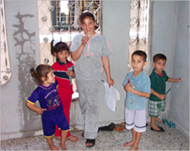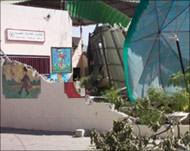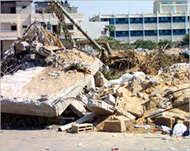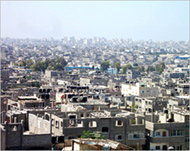Jabalya defies Sharon’s military might
Riham and her family have been besieged in their home in the Jabalya refugee camp since Israeli forces invaded the northern Gaza Strip with the stated aim of stopping Palestinian rocket fire into the Negev town of Sderot.

On a recent evening, Riham, all of 10 years, tried to teach her younger siblings their lessons as well as she could over the incessant clatter of bullets and the dull thud of tank shells.
“When the tanks come, we all sit in one room, but they are all still very scared, especially the little boy,” Riham says, referring to the Israeli tanks and armoured personnel carriers that have positioned themselves not far from them.
Children have been encouraged to stay indoors in Jabalya, and for good reason. The Israeli offensive, the largest since the reoccupation of much of the West Bank in 2002, has been brutal and indiscriminate.
UN schools, chicken farms, refugee shelters, hospitals, mosques and even a kindergarten in front of Riham’s home have been fair game for the ongoing Israeli operation codenamed Days of Penitence.
Lopsided battle
On 4 October, one of the Palestinian victims of Days of Penitence was Islam Dwidar, just 14-years old. Dwidar was shot by Israeli snipers as she was baking bread with her mother.
 |
|
Riham gives lessons to her |
Innocent bystanders such as Dwidar account for roughly 41% of the 100-plus Palestinian fatalities inflicted by the Israeli army operation so far. About a third of them are children, according to an initial investigation by the Israeli human-rights group B’tselem.
Hundreds more have been injured in a lopsided battle that has seen one of the world’s most sophisticated armies pitted against a dirt-poor refugee camp and its resistance fighters, equipped with home-made weaponry and an unshakable conviction that justice is on their side.
But they are fighting against a formidable, almost invisible army. Unlike the first intifada, this time around Israeli troops are rarely seen outside of their vehicles. Instead they remain cooped up in armoured vehicles and bulldozers and Merkava tanks, or hover far above in state-of-the-art helicopter gunships.
Against all odds
Even the unmanned reconnaissance drones, which whir menacingly as they monitor camp activities from afar, are now capable of firing missiles.
 |
|
A Jabalya kindergarten testifies |
It is an innovation only in the Israeli and Indian military’s possession. The pilotless aircraft can stay aloft on reconnaissance and interception missions for up to 36 hours and penetrate as far as 800km (500 miles).
But the refugee camp is hardly wanting in defence tactics.
All along the sewage-strewn streets of Jabalya are embers of dried weeds and burning tyres, whose smoke is used to cloud the view of the Israeli drones.
At one place, camp residents have pinned up an enormous nylon tarpaulin, meant to serve the same purpose, as resistance fighters, toting machine guns and sporting crude face masks, warily roam Jabalya’s narrow alleys.
The fighters do not seem concerned that the odds are overwhelmingly against them. The truth, they say, is on their side.
“Their military is strong, but we are confident that the weak in this case can defeat the strong. God will make us victorious,” said one fighter and father of five. “We’ve been surprised by the amount of support we’ve received here by everyone in the camp.”
Special significance
Camp residents remain likewise defiant, despite the Israeli propaganda leaflets urging them to turn against the fighters, delivered to them through the same aircraft that play havoc with their lives.
In Jabalya, the most densely populated place on earth, the Israeli offensive has a special significance. The camp is both home to the first Palestinian refugees, forced out of their land in historic Palestine in 1948, and the birthplace of the first Palestinian uprising in 1987.
 |
|
Warplanes, tanks and bulldozers |
Um Tariq Najjar was one of these refugees. But the cement-block structure she now calls home is pockmarked with Israeli bullet holes, its windows shattered and its walls lined with cracks.
Tanks and armoured bulldozers rumbled through her backyard on the second day of the offensive to avoid the booby-trapped inner lanes of the camp, literally tearing apart her home in the process.
“We refuse to leave. They forced us out once in 1948, but not again. We’re prepared to die here, even if that means the bulldozer rolls us over the next time,” she said, her voice bristling with defiance.
“They call it Days of Penitence. But for us they are days of perseverance, days of trial. We must be patient.”
Najjar’s neighbour, Um Wail, was still mourning the loss of her husband – he was killed by Israeli gunships earlier in the week. But she too struck a defiant note.
“By what mixed-up standard are we the terrorists?” she asks. “Who kicked whom out of their land? They came to us, we didn’t go to them.”
Waste of time
Back in eastern Jabalya, Riham’s father, Abu Muhammad, pointed from the roof of his home to a buffer zone – reminiscent of the one in southern Lebanon – that is making it ways across the once plentiful fruit orchards of northern Gaza, now vast swathes of emptiness.
The 9-km zone is intended to prevent the firing of Qassam rockets from their maximum range.
“It’s useless though,” says Abu Muhammad. “The fighters don’t go there anyway – the Israelis are wasting their time. They’ll never find a solution to the Qassam problem in this way.”
 |
|
For the camp’s children, going to |
As a daily witness on the front lines, Abu Muhammad is dismissive of Israeli claims that its forces only target fighters, that civilians are the unintended “collateral damage”.
“They don’t care who they’re aiming at – civilians, fighters, it’s all the same to them,” he said.
As if to drive Abu Muhammad’s point home, an Apache gunship materialises overhead, firing a torrent of high-velocity bullets at a group of Palestinians below us.
After we take cover beneath a makeshift structure, he lifts me up, almost nonchalantly, to show me the presumed target of the gunfire.
Frayed credibility
“See that woman and her family who are on the ground for cover?” Abu Muhammad says. “There’s your proof.”
In the distance, the wailing sound of an ambulance signals yet another fallen Palestinian.
 |
|
The sprawling refugee camp has |
Later, when questioned about the incident, an Israeli army spokesperson said a rocket-propelled grenade had been fired from the area – an excuse used so frequently that its credibility has worn thin.
In the meantime, a US State Department spokesman, in a routine step, has called on Israel to avoid harming civilians and to “keep its responses in proportion”. For his part, EU president Bernard Bot has condemned the Israeli use of force as “excessive”.
But if these appeals have made any difference to Israel’s behaviour, residents of the Jabalya camp have yet to feel it. The 10-year-old Palestinian from the camp’s eastern edge, Riham, for one, still struggles to drill school lessons into her siblings amid the clatter of gunfire and the rumble of tanks.
“It’s hard – they can’t concentrate,” she says with a confidence well beyond her years. “But I’m trying to make up for lost time.”